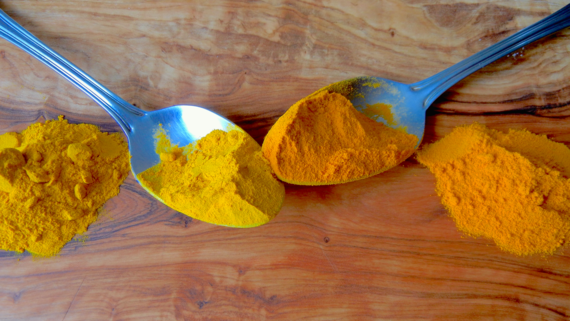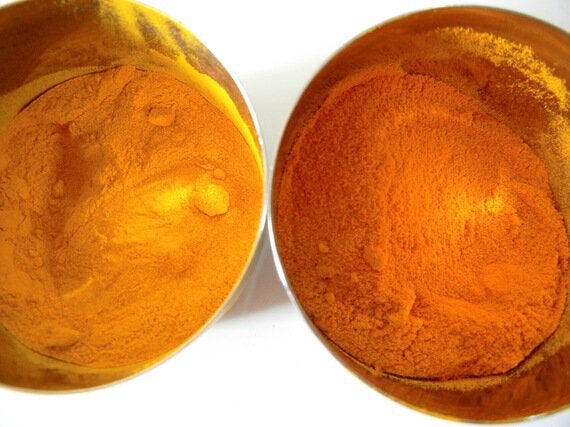
Bulk Barn Turmeric (L) and turmeric from the motherland, India (R)
Punjabi people call it haldi, everyone else knows it as turmeric.
In the last few years, turmeric has made its way onto the shelves of all major grocery stores and into the mainstream spice scene. Its popularity comes from the fact that turmeric carries tons of medicinal properties - curing the flu, sore throats, stomach pains, aching muscles - and Google will point out hundreds of other relieving powers contained in this super spice.
The latest obsession is the "golden milk latte," something I remember my brother and I were forced to drink as kids when we got sick from a cold. Mom would simmer up a batch of milk and swirl in a few spoons of fresh turmeric powder, pour it into giant mugs and make us finish it while it was still warm. We called it haldi doodh, which literally translates to "turmeric milk." Now it just has a fancy title. Thanks, hipsters!
Golden milk might just be the new lemon water.
What is Turmeric?
- It's a traditional Indian spice
- Commonly used as food colouring and a staple spice for Indian curries, marinades, sabzis (vegetables cooked in spices and curry flavours)
- Bright yellow in colour (pure turmeric has a more orange hue)
- Easily available in powder form
- Carries a sharp, earthy and bitter taste
- Comes from the ginger family and the root is from the Curcuma longa plant
Turmeric has a long history of boxing up super healing powers. Let's step back in time to ancient India when turmeric was first used. Thousands of years ago, one of the world's oldest forms of holistic medicine was born called Ayurveda, which involves cleansing the body from undigested food through plant-based drugs, special diets, massages, mediation, yoga, life style changes and more. In Ayurvedic cooking (and all curries) turmeric is the star of the show. Turmeric is often prescribed by Ayurvedic practitioners to support the blood, liver, joints, immune system and digestive tract. In India, about 80 per cent of the rural population depends on traditional Ayurvedic medicine.
According to MedIndia.net, turmeric is "five to eight times stronger than vitamin E and stronger than vitamin C, this antioxidant breakthrough may help boost your immunity, maintain normal cholesterol levels, and puts the brakes on aging." WebMD has a long list of benefits for you to probe through. Here's another 22 surprising uses for turmeric from the Mother Nature Network.
Then in the year 2008, along came Goop, Gwyneth Paltrow's lifestyle site, which noted turmeric as a key anti-inflammatory ingredient to help your skin stay fresh and glowing. She even throws in a Gwyneth-approved turmeric latte recipe and the rest is history, in terms of becoming a trending topic.
My family swears by it. Growing up I saw my mom (and now my younger female cousins) make face masks using honey, homemade yogurt and turmeric. And I have to admit, I've never seen a blemish on my mom's or my cousin's faces, as they've made this mask part of their daily skincare routine.

Bulk Barn Turmeric (L) and turmeric from the motherland, India (R)
Side note: As you see can from the image above, organic turmeric has a much more rich, vibrant colour to it when compared to what I bought from Bulk Barn. My parents' place is always stocked with the real-deal turmeric, straight from the motherland. My mom never buys it here in Canada. Clearly she has some connections abroad. I don't ask.
In the summers back at my parents' place, I often find a jug of turmeric, ginger and lemon tea in the fridge. In the winters they make "golden lattes."
Growing up in the village of Punjab, my mom remembers when her mom (my grandma) and the other elderly villagers used homemade turmeric remedies to cure knee or joint pains. They would make a paste out of mustard oil and fresh turmeric, spread the paste on a hot roti and place it directly on the body where it ached. The roti acts as a compress and the hot paste seeps into the skin, killing off the pain. Clever, right?
I could go on and on about how Punjabi families can't live without using turmeric on a daily basis, but I won't. The bigger overall insight is that staples in any South Asian household, such as neem, henna, coconut oil, homemade yogurt, ghee, jaggery, amla, tulsi and so on are now becoming commercial products in the West. Looks like South Asians were well ahead of the hipsters subculture, which poses the question: Just how long have hipsters been around?

Oh, and it's pronounced tur-mer-ic, not too-mer-ic. Up until I wrote this, even I was saying it wrong.
Follow HuffPost Canada Blogs on Facebook
MORE ON HUFFPOST:
